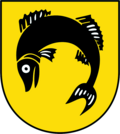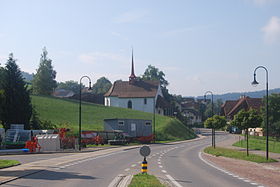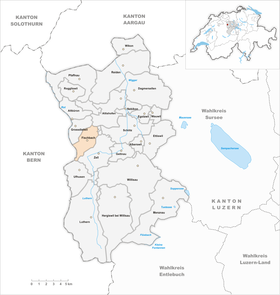Fischbach LU
| LU is the abbreviation for the canton of Lucerne in Switzerland and is used to avoid confusion with other entries of the name Fischbach . |
| Fischbach | |
|---|---|
| State : |
|
| Canton : |
|
| Constituency : | Willisau |
| BFS no. : | 1129 |
| Postal code : | 6145 |
| Coordinates : | 635 599 / 222838 |
| Height : | 632 m above sea level M. |
| Height range : | 592–766 m above sea level M. |
| Area : | 8.05 km² |
| Residents: | 711 (December 31, 2018) |
| Population density : | 88 inhabitants per km² |
|
Proportion of foreigners : (residents without citizenship ) |
9.8% (December 31, 2,015) |
| Website: | www.fischbach-lu.ch |
|
Fischbach |
|
| Location of the municipality | |
Fischbach is a municipality in the Willisau constituency in the canton of Lucerne in Switzerland .
geography
The village is on the road from Zell LU to St. Urban . The stream of the same name flows through the village. The hamlet of Leimbütz (500 m southeast; 649 m above sea level ) on the road to Zell belongs to the community . The scattered settlement of Schönenthül lies on the right bank of the (Gondiswiler-) Rotbach . The Rotbach forms the western border of the place and is also the border with the canton of Bern. There are also dozens of groups of houses and individual farmsteads in the hilly landscape. The highest elevations are the Schönenthülerhöhe ( 763 m above sea level ) and part of the Bodenberg in the Vogelsangwald ( 759 m above sea level ).
The majority of the community area has been cleared and is used for agriculture (80.7% of the community area). Only 5.3% is settlement area; Forest and wood cover a further 13.8% of the area.
Fischbach borders the Lucerne municipalities of Altishofen , Grossdietwil , Ufhusen and Zell LU and the municipality of Gondiswil in the canton of Bern .
population
| Population development | |
|---|---|
| year | Residents |
| 1798 | 500 |
| 1850 | 801 |
| 1860 | 693 |
| 1880 | 782 |
| 1888 | 761 |
| 1900 | 676 |
| 1930 | 703 |
| 1950 | 761 |
| 1980 | 595 |
| 1990 | 631 |
| 2004 | 697 |
The population grew until 1850. The peak of that year was never reached again. In the following decade, the village lost a considerable proportion of its residents through emigration (1850–1860: −13.5%). This decline was largely made up for by 1880. A second exodus took place between 1888 and 1900 (1888–1900: −11.2%). A stagnation phase with slight growth followed by 1930 (1900–1930: + 4.0%), then a slight growth phase until 1950 (1930–1950: + 8.3%). In the following decades up to 1980 there was the third phase of emigration (1950–1980: −21.8%). The population has been growing steadily since this all-time low (1980–2004: +17.1%).
languages
The population uses a highly Alemannic dialect as their everyday language. In the last census in 2000, 93.95% said German, 3.83% Albanian and 0.88% Serbo-Croatian as their main language.
Religions - denominations
In the past, the entire population was a member of the Roman Catholic Church. This has changed, primarily due to immigration from other regions in Switzerland and abroad. Today (as of 2000) it looks like this: There are 70.06% Roman Catholic, 17.99% Evangelical Reformed and 0.88% Free Church Christians. There are also 5.46% Muslims and 2.21% non-denominational. The Muslims are almost exclusively Albanians from Kosovo and Macedonia.
Origin - nationality
At the end of 2014, 659 of the 733 inhabitants were Swiss and 74 (= 10.1%) foreigners. The population consisted of 89.9% Swiss citizens. At the end of 2014, the foreign residents came from Germany (21.6%), Serbia including Kosovo (20.3%), Italy (4.1%), Portugal (4.1%) and Spain (1.4%). 31.1% came from the rest of Europe and 17.6% were of non-European origin.
history
Finds from prehistoric times show that the community was settled early. In historical times, only the Counts of Lenzburg were the lords. Their property passed to the Lords of Balm in the 13th century . Under their reign, the name Viscebach appears for the first time in 1224 in an exchange document between Eberhard von Grünenberg and the St. Urban monastery . Since Rudolf von Balm was involved in the murder of King Albrecht in 1308 , his property fell to the Habsburgs . The community was assigned to the county of Willisau, where it remained until 1415. In that year the city of Lucerne bought the entire county and made it the Landvogtei Willisau. The situation remained that way until 1798, when Fischbach came to the newly formed Altishofen district. As early as 1803 there was a territorial reallocation - and the municipality was assigned to the newly created office of Willisau .
politics
Municipal council
The Fischbach municipal council consists of three members and is set up as follows:
- Josef Vogel ( CVP ): Mayor
- Stefan Häfliger (independent): Mayor
- Eliane Graber ( CVP ): Social Director
Cantonal elections
In the 2015 Cantonal Council elections for the Canton of Lucerne, the share of the vote in Fischbach was: CVP 38.9%, SVP 36.5%, FDP 21.4%, GPS 1.8%, SP 0.9%, glp 0.5%.
National Council elections
In the 2015 Swiss parliamentary elections, the share of the vote in Fischbach was: SVP 46.9%, CVP 30.6%, FDP 14.2%, Greens 2.3%, SP 2.3%, BDP 2.0%, glp 1, 0%.
traffic
The municipality is reached by the Zell-Altbüron-St. Urban integrated into the public transport network. In Zell there is a station on the Lucerne-Langenthal railway line. The place is on the road from Zell to St. Urban. The closest motorway connection is Dagmersellen on the A2 , 12 km away.
Attractions
photos
Web links
- Official website of the municipality of Fischbach (LU)
- Community profile of the cantonal statistical office (PDF, 111 kB)
- Waltraud Hörsch: Fischbach. In: Historical Lexicon of Switzerland .
Individual evidence
- ↑ Permanent and non-permanent resident population by year, canton, district, municipality, population type and gender (permanent resident population). In: bfs. admin.ch . Federal Statistical Office (FSO), August 31, 2019, accessed on December 22, 2019 .
- ↑ Permanent resident population by nationality category, gender and municipality ( memento from January 1, 2015 in the Internet Archive ) (permanent resident population)
- ↑ Balance of the permanent resident population according to demographic components, institutional structure, nationality and gender (Federal Statistical Office, STAT-TAB)
- ^ LUSTAT: Community profile Fischbach ( Memento from May 8, 2016 in the Internet Archive )
- ^ LUSTAT: Community profile Fischbach ( Memento from May 8, 2016 in the Internet Archive )
- ↑ National Council elections 2015: strength of the parties and voter turnout by municipality. In: Results of the National Council elections 2015. Federal Statistical Office, 2016, accessed on June 3, 2016 .






